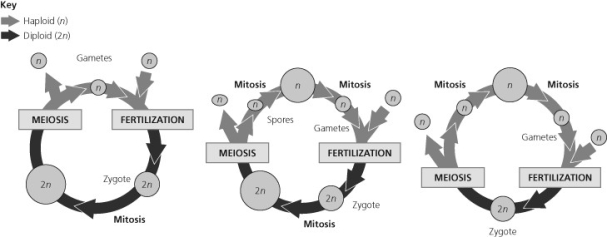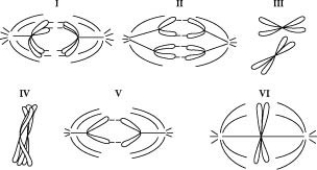A) four
B) two
C) eight
D) a diploid number
Correct Answer

verified
Correct Answer
verified
Multiple Choice
Refer to the life cycles illustrated in the figure below to answer the following questions.
 -In a life cycle such as that shown in part III of the figure above, if the zygote's chromosome number is ten, which of the following statements will be true?
-In a life cycle such as that shown in part III of the figure above, if the zygote's chromosome number is ten, which of the following statements will be true?
A) The sporophyte's chromosome number per cell is ten and the gametophyte's is five.
B) The sporophyte's chromosome number per cell is five and the gametophyte's is ten.
C) The sporophyte and gametophyte each have ten chromosomes per cell.
D) The sporophyte and gametophyte each have five chromosomes per cell.
Correct Answer

verified
Correct Answer
verified
Multiple Choice
During which of the following processes do homologous pairs of chromosomes align adjacent to one another at the metaphase plate of a cell?
A) metaphase of mitosis
B) metaphase I of meiosis
C) telophase II of meiosis
D) metaphase II of meiosis
Correct Answer

verified
Correct Answer
verified
Multiple Choice
Imagine that there are 25 different species of protists living in a tide pool. Some of these species reproduce both sexually and asexually, and some of them can reproduce only asexually. The pool gradually becomes infested with disease-causing viruses and bacteria. Which species are more likely to thrive in the changing environment?
A) The sexually reproducing species is likely to thrive.
B) The asexually reproducing species is likely to thrive.
C) Sexually and asexually reproducing species are equally likely to thrive.
D) Neither species will be able to thrive.
Correct Answer

verified
A
Correct Answer
verified
Multiple Choice
Which of the following statements describes an example of alternation of generations?
A) A grandparent and grandchild each have dark hair, but the parent has blond hair.
B) A diploid plant (sporophyte) produces a spore by meiosis that gives rise to a multicellular, haploid pollen grain (gametophyte) .
C) A diploid animal produces gametes by meiosis, and the gametes undergo fertilization to produce a diploid zygote.
D) A haploid mushroom produces gametes by mitosis, and the gametes undergo fertilization, which is immediately followed by meiosis.
Correct Answer

verified
Correct Answer
verified
Multiple Choice
During which of the following phases of meiosis do homologous chromosomes separate?
A) anaphase II
B) prophase I
C) mitosis
D) anaphase I
Correct Answer

verified
Correct Answer
verified
Multiple Choice
Which of the following processes facilitates the fastest way for organisms to adapt to a changing environment?
A) mutation
B) asexual reproduction
C) sexual reproduction
D) mitosis
Correct Answer

verified
C
Correct Answer
verified
Multiple Choice
Refer to the drawings in the figure below of a single pair of homologous chromosomes as they might appear during various stages of either mitosis or meiosis, and answer the following question(s) .
 -Which diagram represents anaphase II of meiosis?
-Which diagram represents anaphase II of meiosis?
A) I
B) III
C) IV
D) V
Correct Answer

verified
Correct Answer
verified
Multiple Choice
Which of the following processes occur during meiosis but not mitosis?
A) Haploid cells fuse to form diploid cells.
B) Haploid cells multiply into more haploid cells.
C) Diploid cells form haploid cells.
D) A diploid cell combines with a haploid cell.
Correct Answer

verified
Correct Answer
verified
Multiple Choice
Which of the following statements describes the chromosomal makeup of each daughter cell after telophase of meiosis I?
A) The cells are diploid, and the chromosomes are each composed of a single chromatid.
B) The cells are diploid, and the chromosomes are each composed of two chromatids.
C) The cells are haploid, and the chromosomes are each composed of a single chromatid.
D) The cells are haploid, and the chromosomes are each composed of two chromatids.
Correct Answer

verified
Correct Answer
verified
Multiple Choice
If a horticulturist breeding gardenias succeeds in having a single plant with a particularly desirable set of traits, which of the following would be her most probable and efficient route to establishing a line of such plants?
A) Backtrack through her previous experiments to obtain another plant with the same traits.
B) Breed this plant with another plant with much weaker traits.
C) Clone the plant.
D) Force the plant to self-pollinate to obtain an identical one.
Correct Answer

verified
Correct Answer
verified
Multiple Choice
Crossing over of chromosomes normally takes place during which of the following processes?
A) meiosis II
B) meiosis I
C) mitosis
D) mitosis and meiosis II
Correct Answer

verified
B
Correct Answer
verified
Multiple Choice
Which of the following statements correctly describes a karyotype?
A) It is a display of all of the cell types in an organism.
B) It is an organized image of a cell's chromosomes.
C) It reveals the appearance of an organism.
D) It is a display of a cell's mitotic stages.
Correct Answer

verified
Correct Answer
verified
Multiple Choice
Which of the following statements describes one characteristic of each chromosome in a cell during the entire process of meiosis I?
A) Each chromosome is paired with a homologous chromosome.
B) Each chromosome consists of two sister chromatids joined by a centromere.
C) Each chromosome consists of a single strand of DNA.
D) Each chromosome is joined with its homologous pair to form a synaptonemal complex.
Correct Answer

verified
Correct Answer
verified
Multiple Choice
Quaking aspen trees can send out underground stems for asexual reproduction. Sexual reproduction is not as common, but when it does happen, the haploid gametes have 19 chromosomes. How many chromosomes are in the cells of the underground stems?
A) 9
B) 10
C) 19
D) 38
Correct Answer

verified
Correct Answer
verified
Multiple Choice
Which of the following processes occurs when homologous chromosomes cross over in meiosis I?
A) Two sister chromatids get tangled, resulting in one re-sequencing its DNA.
B) Two sister chromatids exchange identical pieces of DNA.
C) Corresponding segments of non-sister chromatids are exchanged.
D) Maternal alleles are "corrected" to be like paternal alleles and vice versa.
Correct Answer

verified
Correct Answer
verified
Multiple Choice
How does natural selection apply to sexual reproduction as opposed to asexual reproduction?
A) Sexual reproduction results in many new gene combinations, some of which will lead to differential reproduction.
B) Sexual reproduction results in the greatest number of new mutations.
C) Sexual reproduction allows the greatest number of offspring to be produced.
D) Sexual reproduction utilizes far less energy than asexual reproduction.
Correct Answer

verified
Correct Answer
verified
Multiple Choice
Many organisms spend most of their life cycle in the diploid state. If meiosis produces haploid cells, how is the diploid number restored for these types of organisms?
A) by DNA replication
B) through the transcription of DNA to RNA
C) by synapsis of the homologous pairs of chromosomes during prophase of meiosis I
D) by fertilization
Correct Answer

verified
Correct Answer
verified
Multiple Choice
At which stage of mitosis are chromosomes usually photographed in the preparation of a karyotype?
A) prophase
B) metaphase
C) anaphase
D) interphase
Correct Answer

verified
Correct Answer
verified
Multiple Choice
Refer to the life cycles illustrated in the figure below to answer the following questions.
 -Which of the life cycles is typical for plants and some algae?
-Which of the life cycles is typical for plants and some algae?
A) I only
B) II only
C) III only
D) I and III
Correct Answer

verified
Correct Answer
verified
Showing 1 - 20 of 64
Related Exams